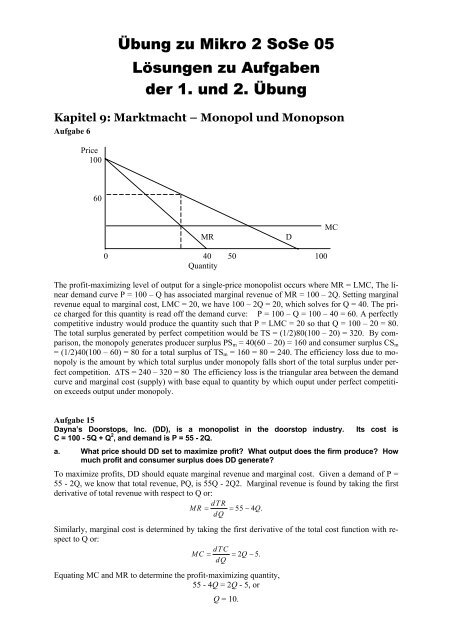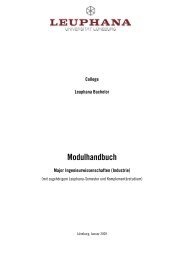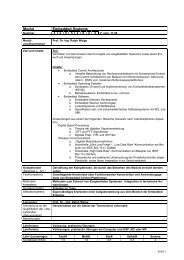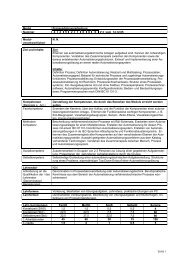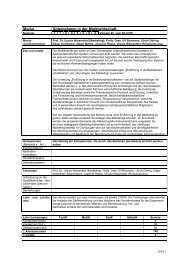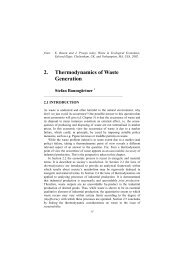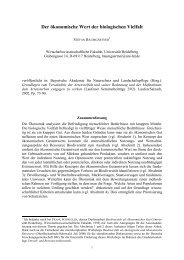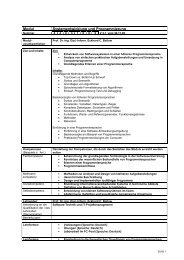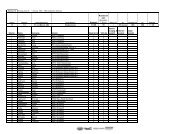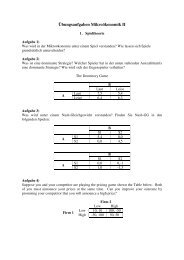Übung zu Mikro 2 SoSe 05 Lösungen zu Aufgaben der 1. und 2 ...
Übung zu Mikro 2 SoSe 05 Lösungen zu Aufgaben der 1. und 2 ...
Übung zu Mikro 2 SoSe 05 Lösungen zu Aufgaben der 1. und 2 ...
Create successful ePaper yourself
Turn your PDF publications into a flip-book with our unique Google optimized e-Paper software.
<strong>Übung</strong> <strong>zu</strong> <strong>Mikro</strong> 2 <strong>SoSe</strong> <strong>05</strong><br />
<strong>Lösungen</strong> <strong>zu</strong> <strong>Aufgaben</strong><br />
<strong>der</strong> <strong>1.</strong> <strong>und</strong> 2. <strong>Übung</strong><br />
Kapitel 9: Marktmacht – Monopol <strong>und</strong> Monopson<br />
Aufgabe 6<br />
Price<br />
100<br />
60<br />
MR D<br />
0 40 50 100<br />
Quantity<br />
The profit-maximizing level of output for a single-price monopolist occurs where MR = LMC, The linear<br />
demand curve P = 100 – Q has associated marginal revenue of MR = 100 – 2Q. Setting marginal<br />
revenue equal to marginal cost, LMC = 20, we have 100 – 2Q = 20, which solves for Q = 40. The price<br />
charged for this quantity is read off the demand curve: P = 100 – Q = 100 – 40 = 60. A perfectly<br />
competitive industry would produce the quantity such that P = LMC = 20 so that Q = 100 – 20 = 80.<br />
The total surplus generated by perfect competition would be TS = (1/2)80(100 – 20) = 320. By comparison,<br />
the monopoly generates producer surplus PSm = 40(60 – 20) = 160 and consumer surplus CSm<br />
= (1/2)40(100 – 60) = 80 for a total surplus of TSm = 160 = 80 = 240. The efficiency loss due to monopoly<br />
is the amount by which total surplus un<strong>der</strong> monopoly falls short of the total surplus un<strong>der</strong> perfect<br />
competition. ∆TS = 240 – 320 = 80 The efficiency loss is the triangular area between the demand<br />
curve and marginal cost (supply) with base equal to quantity by which ouput un<strong>der</strong> perfect competition<br />
exceeds output un<strong>der</strong> monopoly.<br />
Aufgabe 15<br />
Dayna’s Doorstops, Inc. (DD), is a monopolist in the doorstop industry. Its cost is<br />
C = 100 - 5Q + Q 2 , and demand is P = 55 - 2Q.<br />
a. What price should DD set to maximize profit? What output does the firm produce? How<br />
much profit and consumer surplus does DD generate?<br />
To maximize profits, DD should equate marginal revenue and marginal cost. Given a demand of P =<br />
55 - 2Q, we know that total revenue, PQ, is 55Q - 2Q2. Marginal revenue is fo<strong>und</strong> by taking the first<br />
<strong>der</strong>ivative of total revenue with respect to Q or:<br />
dTR<br />
MR = = 55 −4<br />
Q.<br />
dQ<br />
Similarly, marginal cost is determined by taking the first <strong>der</strong>ivative of the total cost function with respect<br />
to Q or:<br />
MC dTC<br />
= = 2Q−5. dQ<br />
Equating MC and MR to determine the profit-maximizing quantity,<br />
55 - 4Q = 2Q - 5, or<br />
Q = 10.<br />
MC
Substituting Q = 10 into the demand equation to determine the profit-maximizing price:<br />
P = 55 - (2)(10) = $35.<br />
Profits are equal to total revenue minus total cost:<br />
π = (35)(10) - (100 - (5)(10) + 10 2 ) = $200.<br />
Consumer surplus is equal to one-half times the profit-maximizing quantity, 10, times the difference<br />
between the demand intercept (the maximum price anyone is willing to pay) and the monopoly price:<br />
CS = (0.5)(10)(55 - 35) = $100.<br />
b. What would output be if DD acted like a perfect competitor and set MC = P? What profit<br />
and consumer surplus would then be generated?<br />
In competition, profits are maximized at the point where price equals marginal cost, where price is given<br />
by the demand curve:<br />
55 - 2Q = -5 + 2Q, or<br />
Q = 15.<br />
Substituting Q = 15 into the demand equation to determine the price:<br />
P = 55 - (2)(15) = $25.<br />
Profits are total revenue minus total cost or:<br />
π = (25)(15) - (100 - (5)(15) + 15 2 ) = $125.<br />
Consumer surplus is<br />
CS = (0.5)(55 - 25)(15) = $225.<br />
c. What is the deadweight loss from monopoly power in part (a)?<br />
The deadweight loss is equal to the area below the demand curve, above the marginal cost curve, and<br />
between the quantities of 10 and 15, or numerically<br />
DWL = (0.5)(35 - 15)(15 - 10) = $50.<br />
d. Suppose the government, concerned about the high price of doorstops, sets a maximum<br />
price at $27. How does this affect price, quantity, consumer surplus, and DD’s profit?<br />
What is the resulting deadweight loss?<br />
With the imposition of a price ceiling, the maximum price that DD may charge is $27.00. Note that<br />
when a ceiling price is set above the competitive price the ceiling price is equal to marginal revenue<br />
for all levels of output sold up to the competitive level of output.<br />
Substitute the ceiling price of $27.00 into the demand equation to determine the effect on theequilibrium<br />
quantity sold:<br />
27 = 55 - 2Q, or Q = 14.<br />
Consumer surplus is<br />
CS = (0.5)(55 - 27)(14) = $196.<br />
Profits are<br />
π = (27)(14) - (100 - (5)(14) + 14 2 ) = $152.<br />
The deadweight loss is $2.00 This is equivalent to a triangle of<br />
(0.5)(15 - 14)(27 - 23) = $2<br />
e. Now suppose the government sets the maximum price at $23. How does this affect price,<br />
quantity, consumer surplus, DD’s profit, and deadweight loss?<br />
With a ceiling price set below the competitive price, DD will decrease its output. Equate marginal revenue<br />
and marginal cost to determine the profit-maximizing level of output:<br />
23 = - 5 + 2Q, or Q = 14.<br />
With the government-imposed maximum price of $23, profits are<br />
π = (23)(14) - (100 - (5)(14) + 14 2 ) = $96.<br />
Consumer surplus is realized on only 14 doorsteps. Therefore, it is equal to the consumer surplus in<br />
part d., i.e. $196, plus the savings on each doorstep, i.e.,<br />
CS = (27 - 23)(14) = $56.<br />
Therefore, consumer surplus is $252. Deadweight loss is the same as before, $2.00.
f. Finally, consi<strong>der</strong> a maximum price of $12. What will this do to quantity, consumer<br />
surplus, profit, and deadweight loss?<br />
With a maximum price of only $12, output decreases even further:<br />
12 = -5 + 2Q, or Q = 8.5.<br />
Profits are<br />
π = (12)(8.5) - (100 - (5)(8.5) + 8.5 2 ) = -$27.75.<br />
Consumer surplus is realized on only 8.5 units, which is equivalent to the consumer surplus associated<br />
with a price of $38 (38 = 55 - 2(8.5)), i.e.,<br />
(0.5)(55 - 38)(8.5) = $72.25<br />
plus the savings on each doorstep, i.e.,<br />
(38 - 12)(8.5) = $22<strong>1.</strong><br />
Therefore, consumer surplus is $293.25. Total surplus is $265.50, and deadweight loss is $84.50.<br />
Aufgabe 17<br />
a. Provide a clear argument in favor of Alcoa’s position.<br />
Although Alcoa controlled about 90 percent of primary aluminum production in the United States, secondary<br />
aluminum production by recyclers accounted for 30 percent of the total aluminum supply.<br />
Therefore, with a higher price, a much larger proportion of aluminum supply could come from secondary<br />
sources. This assertion is true because there is a large stock of potential supply in the economy.<br />
Therefore, the price elasticity of demand for Alcoa’s primary aluminum is much higher (in absolute<br />
value) than we would expect, given Alcoa’s dominant position in primary aluminum production. In<br />
many applications, other metals such as copper and steel are feasible substitutes for aluminum. Again,<br />
the demand elasticity Alcoa faces might be higher than we would otherwise expect.<br />
b. Provide a clear argument against Alcoa’s position.<br />
While Alcoa could not raise its price by very much at any one time, the stock of potential aluminum<br />
supply is limited. Therefore, by keeping a stable high price, Alcoa could reap monopoly profits. Also,<br />
since Alcoa had originally produced the metal reappearing as recycled scrap, it would have consi<strong>der</strong>ed<br />
the effect of scrap reclamation on future prices. Therefore, it exerted effective monopolistic control<br />
over the secondary metal supply.<br />
Kapitel 10: Preisbildung bei Marktmacht<br />
Aufgabe 5<br />
MR should be equal in both markets. Since the price is fixed at 60 in the foreign market, MR is also<br />
fixed at 60 in that market. This means that MR at home should also be 60. We have MRhome = 100-<br />
2Q = 60, which solves for Qhome = 20. Also MC should be equal to 60. MC = 2Q = 60 solves for<br />
Qtotal = 30. Therefore Qforeign = Qtotal-Qhome = 10. Price in the home market = 100 - 20 = 80.<br />
100<br />
80<br />
60<br />
P P<br />
MC<br />
MR<br />
20 30 50 100<br />
Q<br />
Home Market Foreign Market<br />
Q


